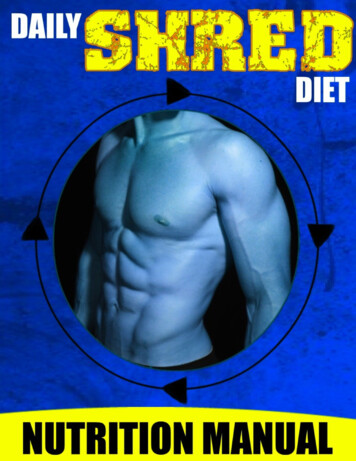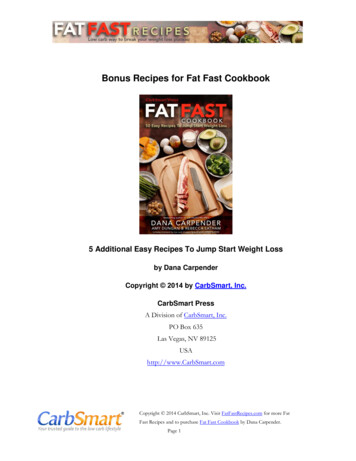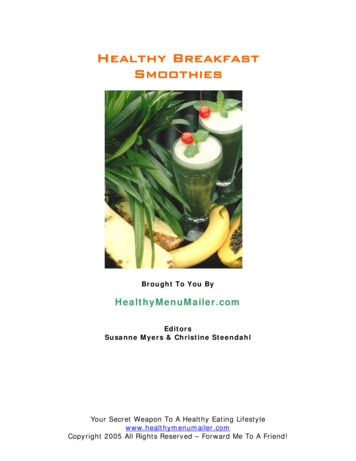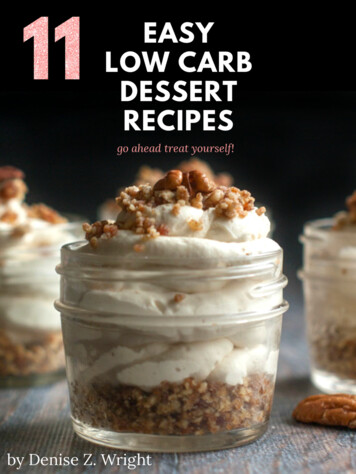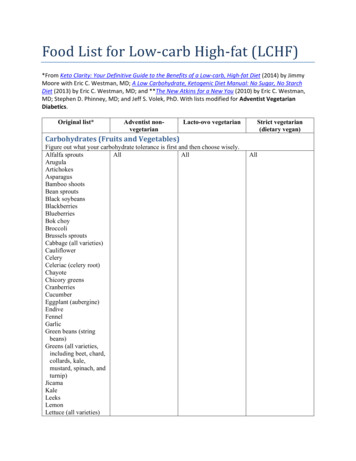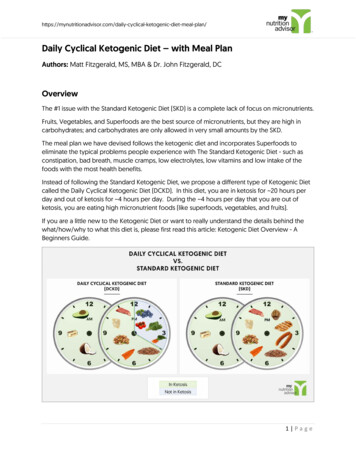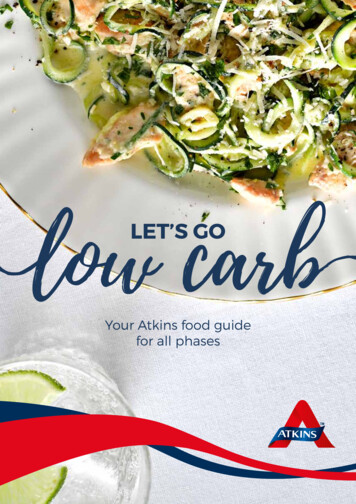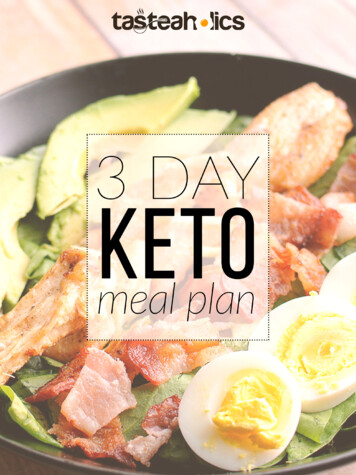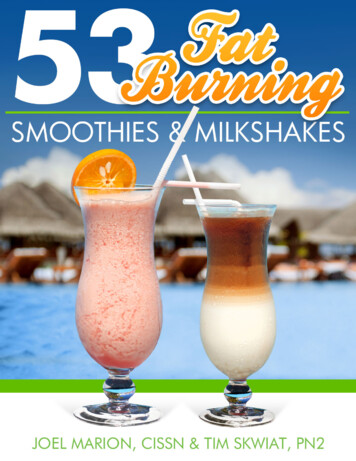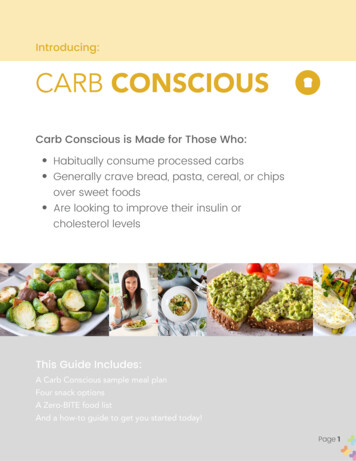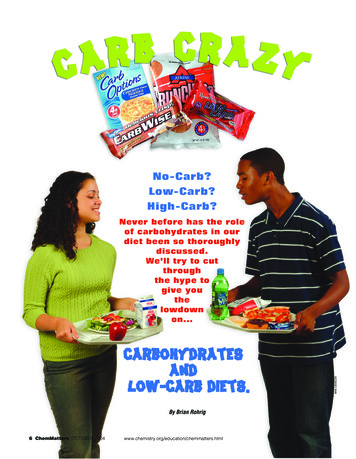
Transcription
No-Carb?Low-Carb?High-Carb?MIKE CIESIELSKINever before has the roleof carbohydrates in ourdiet been so thoroughlydiscussed.We’ll try to cutthroughthe hype togive youthelowdownon.By Brian Rohrig6 ChemMatters, OCTOBER 2004www.chemistry.org/education/chemmatters.html
THOCH2HOCH2HOCH2he word carbohydrate reveals that all carbs are composed ofO HO HO HHHHHHHthree elements: carbon, hydrogen, and oxygen. There areOH HOH HOH HOOOHOthree main categories of harides, and polysaccharides.HOCHHOCHHOCHHOCHHOCH 22222Monosaccharides are composed of one sugar unit and areO HO HO HO HO HO HHHHHHHreferred to as simple sugars. Their empirical formula is generallyHHHHHHOH HOH HOH HOH HOH HOH HOOOOORCH2O. Some common monosaccharides are glucose and fructose.HOAlthough both have a formula of C6H12O6, they have a differentHHHHHHOHOHOHOHOHOHarrangement of atoms. Such compounds are called isomers. Glucoseis produced by plants during photosynthesis. Glucose can be foundThe polysaccharide glycogen is a stored form of glucose.in sports drinks, providing quick energy whenOnce sugar enters our cells, it can do one of three things. It can beyou need it. Glucose is the body’s primary fuelCH2OHconvertedinto energy through cellular respiration. Or it can be dintoglycogen in the liver and muscles, for use as an OHHOfuel. Glycogen is similar to starch but is more extensively branched.dioxide is released as a waste product. If gluOHHFinally, it can be converted into fat if there is more sugar available thancose is not converted into energy, it is conGlucoseis needed.verted into glycogen to be stored.Consider what happens when you wash down a glazed doughnutDisaccharides,alsoknownasdoubleHOCH2 OHwith a sugary soda. As your bloodstream is inundated with sugar, asugars, are composed of two simple sugarHHOtemporary spike in blood sugar will occur. Your pancreas responds bymolecules. The most common disaccharide isHOCH2OHproducing a surge of insulin to quickly rid the bloodstream of thissucrose or table sugar. In order to be used byOHHexcess sugar. This quick release of insulin will cause your blood to then drop suddenly. The sudden drop in blood sugar can cause weakken down into glucose and fructose. Foodness, fatigue, and intense hunger—often leading to a craving for moremanufacturers are more often replacing sucrose in products with frucdelicious glazed donuts. This can create a vicious cycle,tose, because it is cheaper to produce, andCH2OHwhere our blood sugar constantly rises and falls, leadingbecause it is sweeter, less needs to beHOCH2 OHO HHto overeating and eventual weight gain. A well-balancedused. Other common disaccharides areHHHOdiet can help to reduce these sudden peaks and falls inmaltose and lactose (milk sugar).OHHOCH2OHHOblood sugar.Polysaccharides are complex carboOHHOHHSucroseOver the long term, constant spikes in blood sugarhydrates. They are polymers composed ofand insulin are not a good thing. When so much insulinlong chains of sugar units. A commonis produced for so long, your body may become immune to the effectspolysaccharide is starch, which is composed of long chains of glucoseof it, creating a condition known as insulin resistance—often a precurmolecules. Starch is used by plants as a way to store energy, and it cansor to type 2 diabetes. For reabe found in foods such as potatoes, rice, corn, and wheat. Our bodysons not yet fully understood,must break down starch into glucose, which it then uses for energy.the cells can become desensiOther types of complex carbohydrates are not digestible by ourtized to the effects of insulin,body. Chief among these are cellulose, which forms the cell walls ofwith the result that glucose isplant cells, giving them structure and support. Its glucose molecules arenot effectively taken into thelinked together in such a way that our body lacks the necessaryIn the United Statescells and converted into energy.enzymes to break them down. These indigestible polysaccharides areone teen in seven isThe liver then takes over, takingknown as fiber, and they contribute no calories because our bodies canoverweight.SOURCE: SURGEON GENERALthis excess blood sugar andnot convert them into energy. High-fiber foods—such as oats, bran,converting it into fat—leading to obesity. And the overworked pancreasand whole grains—are an essential part of our diet, aiding in digestion.may get worn out from producing so much insulin.Carbohydrates and blood sugarTo understand the effect of carbohydrates on our body, it is important to understand their role on blood sugar. Just like a car requires fuel,so does our body. The body’s major fuel source is glucose, or bloodsugar. However, this blood sugar is not automatically released into thecells. If a car’s engine receives too much fuel, the engine becomesflooded, and it will not start. In the same way, the body must regulatehow much blood sugar enters our cells. This occurs through the production of the hormone insulin, which is manufactured by the pancreas.Think of insulin as the gatekeeper to the cells—it opens the gates andallows glucose to leave the bloodstream and enter our cells.Why not radically cutcarbohydrates from the diet?Eat as much bacon and eggs as you want as long as you forgetabout the toast and orange juice?! Such a suggestion is at the very leastculinary, if not dietary, heresy. But as a result of two decades of risingobesity rates and the sheer popularity of low-carb diets, researchers,doctors, and dietitians began re-examining the theories of Dr. RobertAtkins, who published Dr. Atkins’ Diet Revolution in 1972. He advocatedeating all of the fats and proteins you wanted, and said that if you onlycut out all those carbohydrates, you would lose weight.ChemMatters, OCTOBER 2004 7DAN SHERBOWhat are carbs?
How do low-carb diets work?Are low-carb diets goodfor you?The low-carb diet phenomenon is still too new tojudge its long-term effects. However, two studies recentlypublished in the New England Journal of Medicine offeredsome promising news for adult low-carb dieters. Thesestudies found that participants who lost weight onlow-carb diets had higherlevels of HDL (good) cholesterol and lower levelsAll dietsof triglycerides, or fats,workthan those who lostaccording toweight on different diets.Ketosis: An inefficientone basicThere’s no specific research on teenagers, but youprinciple:way to burn fatshould be wary of going on the diet, especially if you areYou muststill growing. Many participants sacrifice the health benefitsAlthough some claim that a reduced-carbohydrate dietburn moreof the nutrients found in milk, fruit, and whole grains.is nothing more than a reduced-calorie diet in disguise,caloriesOsteoporosis can result from a long-term deficiency of callow-carb diets actually do one thing that is radically differthan youcium in the diet, which could result if milk was totally elimient than any other diet. The majority eliminate most, if notconsume.nated from the diet. Pregnant women should definitely notall, carbohydrates in the initial induction phase of the diet.be on the diet, because the developing fetus can be harmedWhen the body becomes carbohydrate-starved, it must findby the lack of nutrients. Athletes should also avoid lowan alternate energy source.carb diets, since peak athletic performance is dependant onThe first source it taps is the glycogen found in thethequickavailabilityof glucose for energy, as well as relying on glycoliver and muscle. But the body’s glycogen stores can only last about twogenreserves.days. After this, our body turns to fat for energy. However, the breakAny diet is only as successful as the ability to remain on it for life.down of fat in this case does not produce glucose. Instead, the fat isAndmakesure you incorporate plenty of exercise in any weight-lossbroken down into ketones, through an unusual process known as ketoplanyouchoose.sis. Normally, people burn fats without making ketones. Ketosis onlyoccurs when people are carbohydrate-starved.During ketosis, fat is not completely broken down and you don’treceive the “normal” caloric value from burning it. The excess ketonesproduced during ketosis are secreted in our urine and breath. Sometimes this gives your breath a fruity odor, since acetone—a ketone—8 ChemMatters, OCTOBER 2004Brian Rohrig is a chemistry teacher at Jonathan Alder High School in Plain City,OH. His last article for ChemMatters, “Lightning: Nature’s Deadly Fireworks”appeared in the April 2004 LPHOTO BY STAFFAll diets work according to one basic principle: Youmust burn more calories than you consume. How manycalories you burn depends on both metabolism and exercise. You cannot lose weight if you consume more caloriesthan your body uses. By cutting out carbs, you are cuttingback on a lot of calories. Cutting out just sugared sodas,potato chips, and candy bars can reduce your overall calorie consumption dramatically.Another reason low-carb diets are successful is thatfats and protein have better “staying power”. Because carbohydrates are rapidly converted into glucose and then utilized by your body as energy, they do not keep us satiatedfor long. Fat and protein are absorbed more slowly by thebody, so they stay with us longer. Even though low-carbdiets claim you can eat all the fat and protein you want, intruth these foods fill us quicker, causing us to ultimatelyeat less.may be released by the breath during ketosis. Because the kidneys flushout these ketones from the body, it is important to drink a lot of wateron a low-carb diet. Dieters often confirmOtheir body is in ketosis by checking theirCH3 C CH2 Curine with ketone test strips (see “Lab on aO–Stick”in this issue).OConsiderable debate has arisenamongmedical experts as to whether orAcetoacetate(a ketone body)not ketosis is dangerous. Some confuseketosis with a more serious conditionknown as ketoacidosis, which is an extreme form of ketosis sometimessuffered by type 1 diabetics. During ketoacidosis, the pH of the bloodfalls to dangerous levels, because of excessive buildup of acidicketones. This can lead to coma and death if left untreated.Some argue that the body functions even better when usingketones as fuel. Others claim that the brain cannot function as well onketones, and the body will turn to muscle and organ tissue to try toscavenge glucose for fuel. However, most medical authorities today areleaning toward the view that ketosis is a safe bodily processas long as ketones are not produced faster than the bodycan get rid of them.MIKE CIESIELSKIPHOTO BY STAFFNumerous modifications of the Atkins’diet, such as the South Beach Diet and theZone, have since appeared. Many of thesemodified diets have a more balancedapproach, stressing the importance ofavoiding unhealthy saturated fats found inred meat and dairy products, and emphasizing healthier unsaturated fats found innuts, fish, and vegetable oils.Millions have tried the diet with success and testimonials abound. By now,you’ve probably heard a friend or family member give the low-carbdieter litany: “‘I failed on other diets, but this diet worked for mebecause I wasn’t hungry all the time.’” “‘I lost weight faster than onother diets, and I wasn’t hungry all the time.’” Or even, “‘I failed on thisdiet, but at least I wasn’t hungry all the time!’”
October 2004 Teacher’s Guide“Carb Crazy”
Student QuestionsCarb Crazy1. What three elements are in a carbohydrate?2. How is glucose used in the body?3. What polysaccharide is a storage form of glucose?4. What is the relationship between insulin and blood sugar?5. By what basic principle do all diets work?6. How is ketoacidosis different than ketosis?7. Why would an athlete want to avoid a low carb diet?Copyright 2004, American Chemical Society2ChemMatters, April 2004
Answers to Student QuestionsCarb Crazy1. What is a carbohydrate? Carbohydrates are composed of three elements: carbon, hydrogen,and oxygen.2. How is glucose used in the body? Glucose is the body’s primary fuel source. It is broken downduring cellular respiration to release energy. Carbon dioxide is released as a waste product.3. What polysaccharide is a storage form of glucose? Glycogen.4. What is the relationship between insulin and blood sugar? Insulin can be thought as thegatekeeper for blood sugar entering cells. When insulin is released by the pancreas, bloodsugar levels drop.5. By what basic principle do all diets work? You must burn more calories than you consume.6. How is ketoacidosis different than ketosis? During ketosis, fat is not completely broken downand your body produces and excretes ketone bodies. Ketoacidosis is an extreme form of ketosiswhere acid ketone bodies build up faster than they can be excreted. The result is a dangerousdrop in blood pH and, if left untreated, coma and death.7. Why would an athlete want to avoid a low carb diet? Athletes rely on glucose and glycogenreserves for quick energy. Most low-carb diets have an induction phase that consumesavailable glycogen reserves.Copyright 2004, American Chemical Society3ChemMatters, April 2004
Content Reading MaterialsNational Science Education ContentStandard AddressedCarb CrazyAs a result of activities in grades 9-12, all students shoulddevelop understandingScience as Inquiry Standard A: of abilities necessary todo scientific inquiryScience as Inquiry Standard A: about scientific inquiry.aPhysical Science Standard B: of the structure andproperties of matter.aPhysical Science Standard B: of chemical reactions.aLife Science Standard C: of the cell.aLife Science Standard C: of matter, energy, andorganization in living systems.aScience and Technology Standard E: about scienceand technology.aScience in Personal and Social Perspectives StandardF: of personal and community health.aScience in Personal and Social Perspectives StandardF: of science and technology in local, national, and globalchallenges.History and Nature of Science Standard G: of scienceas a human endeavor.History and Nature of Science Standard G: of thenature of scientific knowledge.aaHistory and Nature of Science Standard G: of historicalperspectives.*QFTC-Question From the ClassroomCopyright 2004, American Chemical Society4ChemMatters, April 2004
Reading StrategiesThese content frames and organizers are provided to help students locate and analyzeinformation from the articles. Student understanding will be enhanced when they explore andevaluate the information themselves, with input from the teacher if students are struggling. If youuse these reading strategies to evaluate student performance, you may want to develop agrading rubric such as the one tacceptableEvidenceComplete; details provided; demonstrates deepunderstanding.Complete; few details provided; demonstrates someunderstanding.Incomplete; few details provided; somemisconceptions evident.Very incomplete; no details provided; manymisconceptions evident.So incomplete that no judgment can be made aboutstudent understanding.Copyright 2004, American Chemical Society5ChemMatters, April 2004
Carb saccharidesBriefDescriptionExamplesBroken down intoÎ Please put these terms in theboxes below:Fat, glycogen, insulin, ketosis,CO2, H2O, glucose, cell.gatekeeperGlucose may beconverted toCellularrespirationGlucose may beconverted toENERGYStarvation maylead toEmergency fuelketonesCopyright 2004, American Chemical Society6ChemMatters, April 2004
Anticipation GuidesAnticipation guides help engage students by activating prior knowledge and stimulating studentinterest before reading. If class time permits, discuss their responses to each statement beforereading each article. As they read, students should look for evidence supporting or refuting theirinitial responses.Directions for all Anticipation Guides: In the first column, write “A” or “D” indicating youragreement or disagreement with each statement. As you read, compare your opinions withinformation from the article. In the space under each statement, cite information from the articlethat supports or refutes your original ideas.Carb CrazyMeTextStatement1. All digestible carbohydrates are broken down into glucose so the body can usethem.2. Fructose is more expensive and less sweet than sucrose.3. Indigestible carbohydrates are unhealthy.4. Eating sugary snacks can actually make you hungry sooner.5. To lose weight, you must burn more calories than you eat.6. Your body burns fat before glycogen.7. People on low-carb diets should restrict water intake.8. Proteins and fats are absorbed more quickly in the body than carbohydrates.9. Low carb diets are good for teenagers.Copyright 2004, American Chemical Society7ChemMatters, April 2004
Carb CrazyBackground InformationBoth starch and glycogen are important polysaccharides which act to store the simple sugarmonomers composing them. Both starch and glycogen polymerize within cells by a form ofcondensation synthesis in which a hydroxyl group of one monomer reacts with the anomericcarbon at the opposite end of a second monomer. Molecules of water are eliminated in theprocess. Simple sugars are released from storage when the polysaccaride undergoes the reverseprocess, hydrolysis, in which molecules of water are restored.Starch is made by plant cells, and glycogen, by animals. Both of the polysaccarides, with theirmany exposed hydroxyl groups, become heavily hydrated in their cellular environments. Starchmolecules— huge polysaccarides (m.w. often exceeding 1 million)—are generally of two types:amylose consisting of long, unbranched chains of D-glucose, and amylopectin, highly branched.Glycogen, similar to amylopectin, is even more highly branched. It generally appears in granulesthat also contain enzymes ready to degrade the molecule when conditions are right.Both starch and glycogen are essentially insoluble. If the point is to have glucose ready for instantuse as cellular fuel, why don’t cells simply store the glucose molecules in solution? It turns outthat having that many particles in solution would create a severe osmotic imbalance that wouldeither cause the cells to swell and burst, or, at the very least, would reach an equilbrium state inwhich no additional net gain in glucose molecules would occur.Are all carbohydrates created equal?Do all carbohydrates contribute equally to a rise in blood sugar? Fortunately, no. There are“good” and “bad” carbohydrates, depending on how quickly that carbohydrate is converted toglucose in the bloodstream, as measured by the glycemic index (GI). The GI rates glucose at100, and foods are ranked according to how fast they enter the bloodstream, relative to glucose.For example, if a food has a GI of 50, it is absorbed into the bloodstream half as fast as that ofglucose. Good carbohydrates have a low GI, and bad carbohydrates have a high GI. Whitebread, for example, has a GI of 70, while pumpernickel has a GI of 41. Watermelon has a GI of72, but a plum has a GI of only 24. Instant white rice has a GI of 91, while brown rice only has aGI of 55. Generally, the more refined the food, the quicker it can be broken down and the higherits GI. The more work our body must do to break down a substance, the slower it will be absorbedinto the bloodstream. Apple juice has a higher GI than apples. Baked potatoes have the highestGI of all potatoes at 85. To avoid spikes in blood sugar, with the resultant insulin spike followedby a crash in blood sugar, choose carbohydrates with a low GI.The GI is not a perfect measure of what foods to eat, however. Fructose, for example, has a GI ofonly 20. Scientists actually give rats large does of fructose to make them insulin resistant.Connections to Chemistry ConceptsRelating the Caloric values of foods to the concepts surrounding Heats of Combustion is relevantto the article’s discussions about diet plans.Possible Student MisconceptionsStudents frequently mistake food Calories (actually kilocalories) for the unit of energy the calorie.The “kilo” portion is of course very important. Just warming a 200 g cup of water from roomtemperature to normal body temperature (25 oC to 37 oC) requires 2400 calories. Is a 2400calorie (not 2400 Calorie or 2400 kilocalorie) diet sufficient to maintain human body temperaturefor 24 hours?Copyright 2004, American Chemical Society8ChemMatters, April 2004
Students may also wonder about the term “burning” food for calories. Misconceptions arecompounded by hearing foods described as “fuels”. The way the cells depend on enzymes tolower the activation energy necessary for breaking chemical bonds during metabolism is a basictopic in many modern biology curricula. A brief discussion may clear up the confusion if it occurs.Demonstrations and LessonsThe ACS Chemistry in the Community, 4th Ed. textbook as well as other basic high schoolchemistry textbooks, has a laboratory investigation in which students construct a calorimeterusing a soda can containing 100 ml of water. Students relate the temperature increase in thewater to the weight of paraffin consumed by a burning candle in order to determine the Heat ofCombustion of paraffin in kJ/g. A similar procedure might be devised to determine the heat ofcombustion of small piece of wood. Comparisons between paraffin (lipid) and wood(carbohydrate) heats of combustion would be relevant to a discussion about the relative roles offats and carbohydrates in a diet plan.Connections to the Chemistry CurriculumOrganic chemistry, thermal energy, and polymers are topics that relate to the content of thearticle. In addition, the ways in which information is collected and analyzed for making informedconsumer choices is a critical goal of every good high school science program.Suggestions for Student Projects1. Students can run analyses of their own diets. The analysis can be a quick and simple activitysuch as keeping a list of what is eaten on one typical day and then placing each food into theappropriate place on the food pyramid. A more complex analysis might involve a record of whatwas eaten over several days followed by a detailed analysis of Caloric content, as well ascarbohydrate, fat, and protein content (on a percent by Calorie basis), including even theamounts of vitamins and minerals. ChemCom provides a rather extensive table of foods showingthis type of nutritional information. See also the list of suggested Web sites for this article.2. Students can perform “blind taste tests” of “low-carb” or “sugar-free” food products to comparethem to their sugary counterparts3. Students could examine one of the current “fad” diets and either prepare a paper or give aclass presentation on the rationale behind the diet. Different teams of students could debate themerits of the diet—one side arguing in its favor, the other opposing the diet.Anticipating Student QuestionsStudents will want to know if a diet like the Atkins diet is good for them. As the article points out,there have been no significant long-term studies to find out whether minimizing carbs in ateenager’s diet plan advisable or even safe for losing weight.Websites for Additional Information and IdeasStudents will be interested in finding out about, and perhaps, comparing other diet plans.For an informative and entertaining account of several diet fads of the past go tohttp://www.dietbites.com/article0159.htmlMore of diet plans are found at this site. Be sure to check out the Paleolithic bodystory/fat diets.html#fplanCopyright 2004, American Chemical Society9ChemMatters, April 2004
Atkins, who published Dr. Atkins’ Diet Revolution in 1972. He advocated eating all of the fats and proteins you wanted, and said that if you only cut out all those carbohydrates, you would lose weight. H HOCH2 H OH H H HO OH OH O H HOCH2 H OH H H OH H O H HOCH2 H OH H H OH O O H H HOCH2 H
